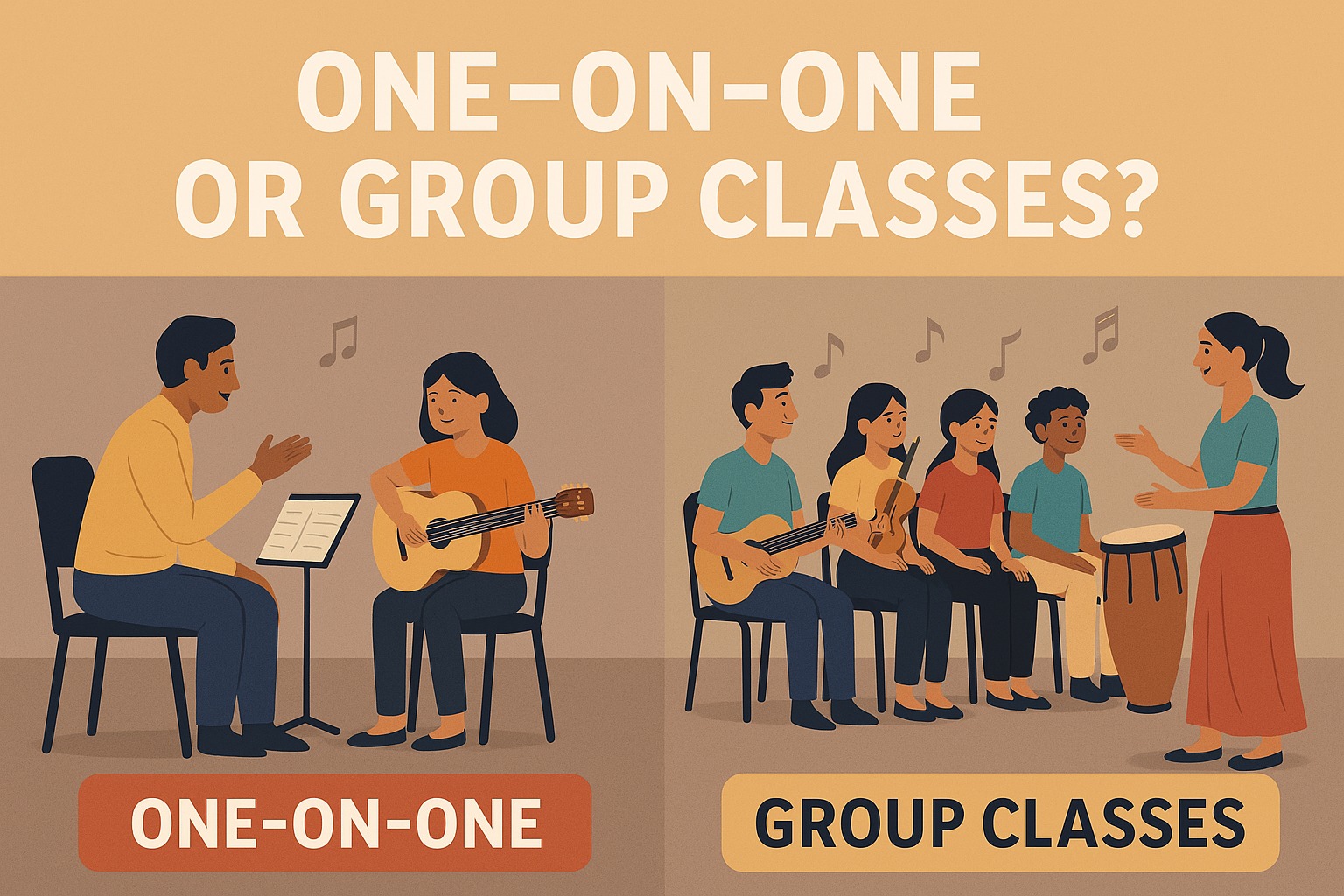The Modern Dilemma of Music & Dance Education – One-one-One or Group Classes?
In today’s dynamic educational landscape, music and dance institutes face an important decision that directly shapes the future of their students and the overall learning environment — should they offer personalized one-on-one or group classes? This choice goes far beyond just scheduling or class sizes. It influences the depth of student engagement, the quality of instruction, the ability to foster creativity, and even the long-term outcomes of learners.
Each model comes with its own unique strengths. One-on-one classes enable a more focused, customized approach to learning, while group classes encourage collaboration, performance readiness, and peer-driven motivation. For institutes, making the right decision involves evaluating their core teaching philosophy, available resources, and the specific needs of their student community.
This blog dives deep into the pros and cons of each method, helping educators, academy owners, and even parents understand what works best for different learning goals. Whether you’re planning to revise your curriculum or start a new batch, understanding the value of one-on-one or group classes can be the key to building a successful and student-centred music or dance academy.
Understanding One-on-One Classes: A Personalized Approach
One-on-one classes provide individualized attention, allowing instructors to tailor lessons to a student’s unique pace, strengths, and areas needing improvement. This bespoke approach is particularly beneficial for beginners requiring foundational skills or advanced learners aiming for mastery. Additionally, private lessons offer flexible scheduling, accommodating students with varying availability.
Exploring Group Classes: Community, Energy, and Cost-Efficiency
Group classes cultivate a sense of community, enabling students to engage with peers, share insights, and motivate each other. This collaborative environment enhances ensemble skills, essential in dance and musical performances. Furthermore, group sessions are generally more cost-effective, making quality education accessible to a broader audience.
📌 Whether you’re offering one-on-one or group classes, keeping student attendance organized by format, batch, and time can quickly become messy. Our Student Attendance Sheet simplifies it all — so you can focus more on teaching and less on tracking.
Learning Outcomes: Comparing Progress in Both Formats
While private lessons focus on individualized progress, group classes emphasize collective growth. Studies indicate that group settings can enhance retention of information due to varied activities and peer interactions. Conversely, private lessons can lead to higher performance in specific skill areas due to concentrated focus.
Teacher’s Perspective: Managing Time, Energy, and Impact
From an instructor’s viewpoint, one-on-one classes demand intense focus but allow for deep mentorship. Group classes, while requiring adept classroom management skills, can be energizing due to group dynamics and allow instructors to impact more students simultaneously.
Economic Factors: What Makes More Sense Financially?
Financially, group classes can be more lucrative for institutes as multiple students contribute to the revenue simultaneously. However, premium pricing for personalized one-on-one sessions can balance this out. Institutes must weigh the potential for higher income per hour against the exclusivity and pricing of private lessons.
Space & Infrastructure: How Each Format Affects Your Setup
Group classes necessitate larger spaces with appropriate acoustics and flooring to accommodate multiple students safely. One-on-one sessions can operate in smaller rooms, reducing overhead costs. The choice impacts decisions regarding studio size, location, and associated expenses.
Hybrid Approach: Can Institutes Offer the Best of Both Worlds?
A hybrid model allows institutes to cater to diverse student needs by offering both one-on-one or group classes. For instance, foundational techniques can be taught in group settings, while specialized skills are honed in one-on-one sessions. This approach maximizes resource utilization and broadens the institute’s appeal.
Also Read: Should You Offer Online Classes? The Pros and Cons for Academies
What Do Students and Parents Prefer? Survey Insights
Understanding the preferences of students and their families is crucial. Surveys have shown that out-of-school music participants and nonparticipants had a stronger preference for small group learning environments. Additionally, a study indicated that students receiving group instruction achieved musically at a level equal to or slightly superior to those receiving private instruction. These insights can guide institutes in structuring their offerings to align with market demands.
Strategic Tip: Offer Tiered Learning Models
Institutes can design tiered programs to cater to varying skill levels:
- Beginner: Group classes focusing on fundamentals, fostering peer interaction.
- Intermediate: Combination of group sessions for ensemble skills and periodic one-on-one lessons for personalized feedback.
- Advanced: Primarily one-on-one sessions tailored to individual artistic goals and mastery.
This structure provides a clear progression path, accommodating diverse learning needs.
There’s No One-Size-Fits-All
Both one-on-one or group classes offer distinct advantages that can shape the learning journey of every student in unique ways. While one-on-one classes provide deep personal attention and tailored instruction, group classes foster social learning, team spirit, and performance-based confidence. The choice between One-one-one or group classes isn’t always about one being better than the other, it’s about finding what fits your students, your teaching style, and your institute’s long-term goals.
Music and dance institutes should take a thoughtful approach when designing their class structure. Consider your available resources, the age group and goals of your learners, and your institute’s core philosophy. Are your students looking for competitive training, casual learning, performance experience, or therapy-based expression? These answers can help you create a more balanced offering.
Flexibility plays a crucial role in today’s evolving learning landscape. Offering a combination of one-on-one or group classes or even hybrid options not only attracts a wider audience but also shows your commitment to meeting diverse needs. Ultimately, responsiveness to student preferences and continuous feedback will shape your institute’s success, sustainability, and positive reputation in the long run.


